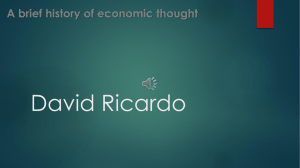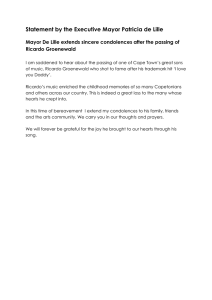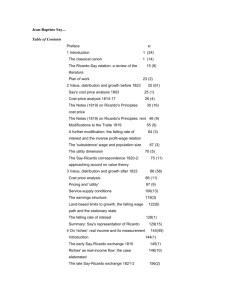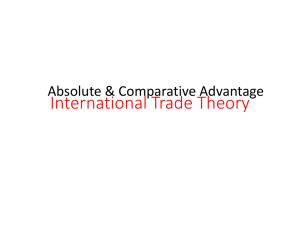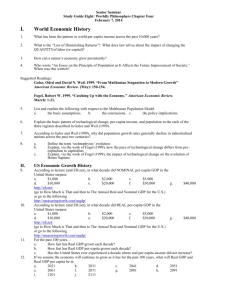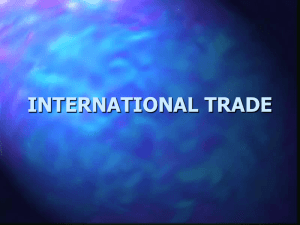Ricardo’s Theory of Comparative Advantage: Old Idea, New Evidence Please share
advertisement
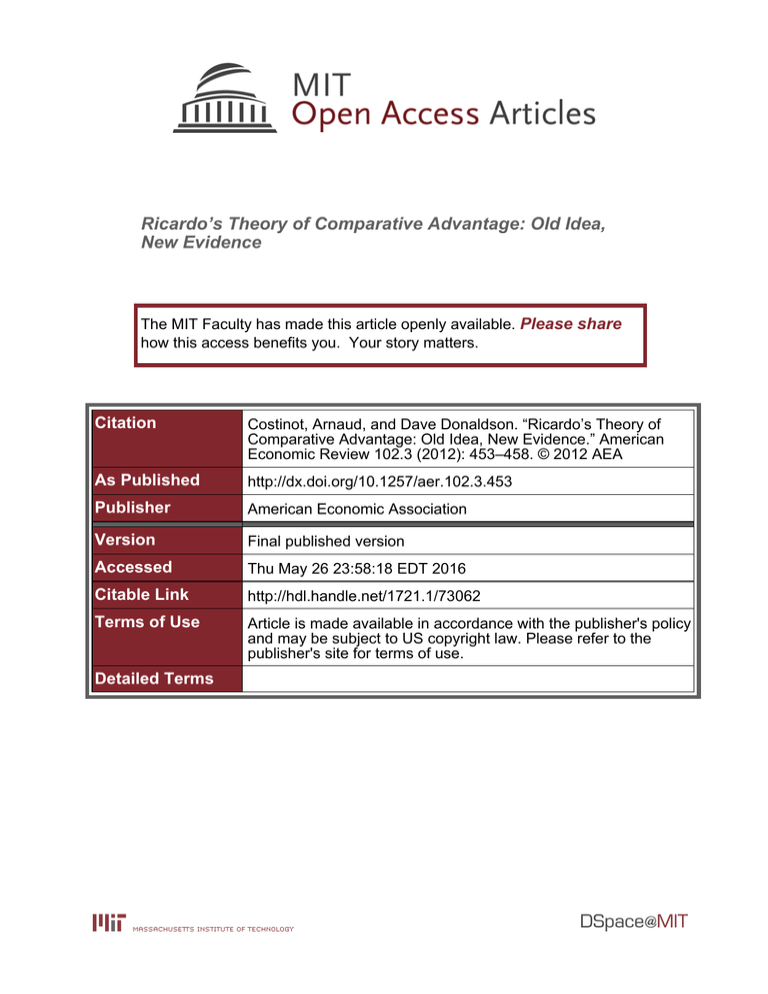
Ricardo’s Theory of Comparative Advantage: Old Idea,
New Evidence
The MIT Faculty has made this article openly available. Please share
how this access benefits you. Your story matters.
Citation
Costinot, Arnaud, and Dave Donaldson. “Ricardo’s Theory of
Comparative Advantage: Old Idea, New Evidence.” American
Economic Review 102.3 (2012): 453–458. © 2012 AEA
As Published
http://dx.doi.org/10.1257/aer.102.3.453
Publisher
American Economic Association
Version
Final published version
Accessed
Thu May 26 23:58:18 EDT 2016
Citable Link
http://hdl.handle.net/1721.1/73062
Terms of Use
Article is made available in accordance with the publisher's policy
and may be subject to US copyright law. Please refer to the
publisher's site for terms of use.
Detailed Terms
American Economic Review: Papers & Proceedings 2012, 102(3): 453–458
http://dx.doi.org/10.1257/aer.102.3.453
Ricardo’s Theory of Comparative Advantage:
Old Idea, New Evidence †
By Arnaud Costinot and Dave Donaldson*
itself … [because] the model implies
­complete specialization in equilibrium…
. This in turn means that the differences
in labor requirements cannot be observed,
since imported goods will almost never be
produced in the importing country.
The anecdote is famous. A mathematician,
Stan Ulam, once challenged Paul Samuelson
to name one proposition in the social sciences
that is both true and nontrivial. His reply was:
“Ricardo’s theory of comparative advantage”;
see Samuelson (1995, p. 22). Truth, however,
in Samuelson’s reply refers to the fact that
Ricardo’s theory of comparative advantage is
mathematically correct, not that it is empirically valid. The goal of our paper is to assess the
empirical performance of Ricardo’s ideas.
To bring Ricardo’s ideas to the data, one must
overcome a key empirical challenge. Suppose, as
Ricardo’s theory of comparative advantage predicts, that different factors of production specialize in different economic activities based on their
relative productivity differences. Then, following Ricardo’s famous example, if English workers are relatively better at producing cloth than
wine compared to Portuguese workers, England
will produce cloth, Portugal will produce wine,
and at least one of these two countries will be
completely specialized in one of these two sectors. Accordingly, the key explanatory variable in
Ricardo’s theory, relative productivity, cannot be
directly observed.
This identification problem is emphasized by
Deardorff (1984, p. 476) in his review of empirical work on the Ricardian model of trade:
Problems arise, however, most having to
do with the observability of [productivity by industry and country]. The … problem is implicit in the Ricardian model
A similar identification problem arises in the
labor literature in which the self-selection of
individuals based on comparative advantage is
often referred to as the Roy model. As Heckman
and Honoré (1990) have shown, if general distributions of worker skills are allowed, the Roy
model—and hence Ricardo’s theory of comparative advantage—has no empirical content.
Econometrically speaking, the Ricardian model
is not nonparametrically identified.
How can one solve this identification problem? One possibility consists in making untestable functional form assumptions about the
distribution of productivity across different
factors of productions and economic activities. These assumptions can then be used to
relate productivity levels that are observable to
those that are not. In a labor context, a common strategy is to assume that workers’ skills
are log-normally distributed. In a trade context, building on the work of Eaton and Kortum
(2002), Costinot, Donaldson, and Komunjer
(forthcoming) have shown how the predictions
of the Ricardian model can be tested by assuming that productivity levels are independently
drawn from Fréchet distributions across countries and industries.
This paper proposes an alternative empirical strategy that does not rely on identification by functional form. Our basic idea, as in
Costinot and Donaldson (2011), is to focus on
­agriculture, a sector of the economy in which
scientific knowledge of how essential inputs
such as water, soil, and climatic conditions map
into outputs is uniquely well understood. As a
consequence of this knowledge, agronomists are
able to predict how productive a given parcel of
* Costinot: MIT, Department of Economics, MIT,
50 Memorial Drive, Cambridge, MA 02142 and NBER
(e-mail: costinot@mit.edu). Donaldson: MIT Department
of Economics, MIT, 50 Memorial Drive, Cambridge, MA
02142 and NBER (e-mail: ddonald@mit.edu). We thank Pol
Antràs, Chang-Tai Hsieh, and Esteban Rossi-Hansberg for
comments and Meredith McPhail and Cory Smith for excellent research assistance.
†
To view additional materials, visit the article page at
http://dx.doi.org/10.1257/aer.102.3.453.
453
454
land, which will we refer to as a “field,” would
be were it to be used to grow any one of a set
of crops. In this particular context, the econometrician therefore knows the productivity of a
field in all economic activities, not just those in
which it is currently employed.
Our strategy can be described as follows.
We first establish how, according to Ricardo’s
theory of comparative advantage, total output
of various crops should vary across countries as
a function of: (i) the vector of productivity of
the fields that countries are endowed with, and
(ii) the producer prices that determine the allocation of fields across crops.1 We then combine
these theoretical predictions with productivity
and price data from the Food and Agriculture
Organization (FAO). Our dataset consists of 17
major agricultural crops and 55 major agricultural countries. Using this information, we can
compute predicted output levels for all crops and
countries in our sample and ask: How do predicted output levels compare with those that are
observed in the data?
Our empirical results show that the output
levels predicted by Ricardo’s theory of comparative advantage agree reasonably well with
actual data on worldwide agricultural production. Despite all of the real-world considerations
from which Ricardo’s theory abstracts, a regression of log output on log predicted output has a
(precisely estimated) slope of 0.21. This result
is robust to a series of alternative samples and
specifications.
The rest of the article is organized as follows.
Section I derives predicted output levels in an
economy where factor allocation is determined
by Ricardian comparative advantage. Section II
describes the data that we use to construct
measures of both predicted and actual output.
Section III compares predicted and observed
output levels, and Section IV offers some concluding remarks.
I. Ricardian Predictions
The basic environment is the same as in
Costinot (2009). We consider a world economy
comprising c = 1, … , C countries, g = 1, … , G
1
MAY 2012
AEA PAPERS AND PROCEEDINGS
In line with Ricardo’s theory of comparative advantage,
the focus of our paper is on the supply-side of the economy,
not the demand-side considerations that would ultimately
pin down prices around the world. goods, and f = 1, … , F factors of production. In
our empirical analysis, a good will be a crop and
a factor of production will be a parcel of land
or “field.” Factors of production are immobile
across countries and perfectly mobile across
sectors. Lcf ≥ 0 denotes the inelastic supply of
factor f in country c. Factors of production are
perfect substitutes within each country and sector but vary in their productivity A gcf ≥ 0. Total
output of good g in country c is given by
F
Q gc = ∑ A gcf L gcf ,
f=1
where L gcf is the quantity of factor f allocated to
good g in country c. The variation in A
gcf is the
source of Ricardian comparative advantage. If
two factors f1and f2located in country c are such
that A gcf22 / A gcf12 > A gcf21 / A gcf11 for two goods g1 and
g2, then field f2has a comparative advantage in
good g2.2
Throughout this article, we focus on the
­supply-side of this economy by taking producer
prices p gc ≥ 0 as given. We assume that the allocation of factors of production to each sector in
each country is efficient and solves
{ C
G
G
}
max
∑
∑ p gc Q gc | ∑ L gcf ≤ Lcf .
g
L cf
c=1 g=1
g=1
Since there are constant returns to scale, a
competitive equilibrium with a large number
of profit-maximizing firms would lead to an
efficient allocation. Because of the linearity of
aggregate output, the solution of the previous
maximization problem is easy to characterize.
As in a simple Ricardian model of trade with
two goods and two countries, each factor should
be employed in the sector that maximizes A gcf p gc ,
2
The present model, like the Roy model in the labor
literature, features multiple factors of production. In international trade textbooks, by contrast, Ricardo’s theory of
comparative advantage is associated with models that feature only one factor of production, labor. In our view, this
particular formalization of Ricardo’s ideas is too narrow for
empirical purposes. The core message of Ricardo’s theory of
comparative advantage is not that labor is the only factor of
production in the world, but rather that relative productivity
differences, and not absolute productivity differences, are
the key determinant of factor allocation. As argued below,
the present model captures exactly that idea. A New Test of Ricardo’s Ideas
VOL. 102 NO. 3
independently of where other factors are being
employed.
Assuming that the efficient allocation is
unique,3 we can express total output of good g
in country c at the efficient allocation as
(1)Q gc = ∑ A gcf Lcf ,
f∈ gc
where gc is the set of factors allocated to good
g in country c :
(2)
{
}
A gcf
p gc ′
_
if g′ ≠ g .
gc = f = 1, … F | _
>
p gc
A gcf′
Equations (1) and (2) capture Ricardo’s idea
that relative rather than absolute productivity
differences determine factor allocation and, in
turn, the pattern of international specialization.
II. Data
To assess the empirical performance of
Ricardo’s ideas we need data
on actual output
levels, which we denote by Q
˜ gc , as well as data
to compute predicted output levels, which we
denote by Q gc in line with Section I. According
to equations (1) and (2), Q gc can be computed
using data on productivity, A gcf , for all factors of
production f ; endowments of different factors,
Lcf ; and producer prices, p gc . We describe our
construction of such measures here. Since the
predictions of Ricardo’s theory of comparative
advantage are fundamentally cross-sectional in
nature, we work with the data from 1989 only;
this is the year in which the greatest overlap in
the required measures is available.
We use data on both agricultural output ( Q˜ gc )
g
and producer prices ( p c ) by country and crop
from FAOSTAT. Output is equal to quantity harvested and is reported in metric tons. Producer
prices are equal to prices received by farmers net
of taxes and subsidies and are reported in local
3
In our empirical analysis, two out of 101,757 grid cells,
the empirical counterparts of factors f in the model, are such
that the value of their marginal products A gcf p gc is maximized in more than one crop. Thus, the efficient allocation
is unique only up to the allocation of these two grid cells.
Dropping these two grid cells has no effect on the coefficient
estimates presented in Table 1. 455
currency units per tonne. Imperfect data reporting to the FAO means that some output and price
observations are missing. We first work with a
sample of crops and countries that is designed
to minimize the number of unreported observations. This sample comprises 55 countries and
17 crops.4 In the remaining sample, whenever
output data are missing we assume that there
is no production of that crop in that country.
Similarly, whenever price data are unreported
for a given observation, both quantity produced
and area harvested are also reported as zero in
the FAO data. In these instances, we therefore
replace the missing price entry with a zero.5
Our data on productivity (A gcf ) come from
version 3.0 of the Global Agro-Ecological
Zones (GAEZ) project run by the International
Institute for Applied Systems Analysis (IIASA)
and the FAO (IIASA/FAO 2012). We describe
this data in detail in Costinot and Donaldson
(2011) but provide a brief description here; see
also Nunn and Qian (2011). The GAEZ project aims to make agronomic predictions about
the yield that would obtain for a given crop at a
given location for all of the world’s major crops
and all locations on Earth. Data on natural inputs
(such as soil characteristics, water availability,
topography and climate) for each location are
fed into an agronomic model of crop production with distinct parameters for each variety of
each crop. These models condition on a level of
variable inputs, and GAEZ makes available the
output from various scenarios in which different
levels of variable inputs are applied. We use the
scenario that corresponds to a “mixed” level of
4
The countries are: Argentina, Australia, Austria,
Bangladesh, Bolivia, Brazil, Bulgaria, Burkina Faso,
Cambodia, Canada, China, Colombia, Democratic Republic
of the Congo, Denmark, Dominican Republic, Ecuador,
Egypt, El Salvador, Finland, France, Ghana, Honduras,
Hungary, Iceland, Indonesia, Iran, Ireland, Israel, Jamaica,
Kenya, Laos, Lebanon, Malawi, Mozambique, Namibia,
Netherlands, Nicaragua, Norway, Paraguay, Peru, Poland,
Romania, South Africa, Spain, Suriname, Sweden, Togo,
Trinidad and Tobago, Tunisia, Turkey, USSR, United States,
Venezuela, Yugoslavia, and Zimbabwe. The crops are: barley, cabbages, carrots and turnips, cassava, coconuts, seed
cotton, groundnuts (with shell), maize, onions (dry), rice
(paddy), sorghum, soybeans, sugar cane, sweet potatoes,
tomatoes, wheat, potatoes (white). 5
We have also experimented with replacing missing
prices with their world averages across producing countries
adjusted for currency differences. The empirical results in
Table 1 are insensitive to this alternative. 456
AEA PAPERS AND PROCEEDINGS
inputs, where the farmer is assumed to be able
to apply inputs differentially across subplots
within his or her location, and in which irrigation is available. It is important to stress that the
thousands of parameters that enter the GAEZ
model are estimated from countless field and lab
experiments, not from statistical relationships
between observed country-level output data
(such as that
from FAOSTAT which we use here
to construct Q
˜ gc ) and natural inputs.
The spatial resolution of GAEZ outputs is
governed by the resolution of the natural input
whose resolution is most coarse, the climate
data. As a result the GAEZ productivity predictions are available for each five–arc-minute grid
cell on Earth. The land area of such a cell varies
by latitude but is 9.2 by 8.5 km at the Tropics.
The median country in our dataset contains
4,817 grid cells, but a large country such as the
United States comprises 157,797 cells. Since the
grid cell is the finest unit of spatial heterogeneity
in our dataset we take each grid cell to be a distinct factor of production f and the land area of
each grid cell to be the associated endowment,
Lcf. Hence, our measure of the productivity of
factor f if it were to produce crop g in country
c, A gcf , corresponds to the GAEZ project’s predicted “total production capacity (metric tons/
ha).” We match countries (at their 1989 borders)
to grid cells using GIS files on country borders
from the Global Administrative Areas database.
A sample of the GAEZ predictions can be
seen in Figure 1. Here we plot, for each grid
cell on Earth, the predicted relative productivity in wheat compared to sugar cane (the two
most important crops by weight in our sample).
As can be seen, there exists a great deal of heterogeneity in relative productivity throughout
the world, even among just two of our 17 crops.
In the next section we explore the implications
of this heterogeneity—heterogeneity that is
at the core of Ricardo’s theory of comparative
­advantage—for determining the pattern of international specialization across crops.
III. Empirical Results
We are now ready to bring Ricardo’s ideas
to the data. To overcome the identification
problem highlighted by Deardorff (1984) and
Heckman and Honore (1990), we take advantage of the GAEZ data, together with the other
data described in Section II, to ­
predict the
MAY 2012
Relative
wheat-to-sugar cane
productivity
High: ≥ 12,033
Low: 0
Figure 1. An Example of Relative Productivity
Differences
Notes: Ratio of productivity in wheat (in metric tons/ha) relative to productivity in sugar cane (in metric tons/ha). Areas
shaded white have either zero productivity in wheat, or zero
productivity in both wheat and sugarcane. Areas shaded dark,
with the highest value (≥ 12,033), have zero productivity in
sugar cane and strictly positive productivity in wheat.
Source: IIASA/FAO (2012)
amount of output (Q gc ) that country c should
produce in crop g according to Ricardo’s theory of comparative advantage, i.e., according to equations (1) and (2). We then compare
these predicted output
levels to those that are
observed in the data ( Q˜ gc ).
In the spirit of the “slope tests” in the
Heckscher-Ohlin-Vanek literature, see Davis
and Weinstein (2001), we implement this comparison by simply regressing, across countries
and crops, data on actual output on measures
of predicted output. Like Davis and Weinstein
(2001), we assess the empirical performance of
Ricardo’s ideas by studying whether (i) the slope
coefficient in this regression is close to unity;
and (ii) the coefficient is precisely estimated.
Compared to these authors, however, we have
little confidence in our model’s ability to predict
absolute levels of output. The reason is simple:
the model presented in Section II assumes that
the only goods produced (using land) in each
­country are the 17 crops for which GAEZ productivity data are available. In reality there are
many other uses of land, so the aggregate amount
of land used to grow the 17 crops in our study
is considerably lower than that assumed in our
analysis. To circumvent this problem, we simply
estimate our regressions in logs.6 Since the core
6
In order to measure the gains from the economic integration of US agricultural markets between 1880 and 2000,
Costinot and Donaldson (2011) have developed a methodology that uses additional data on aggregate land use to c­ orrect
A New Test of Ricardo’s Ideas
VOL. 102 NO. 3
457
Table 1—Comparison of Actual Output to Predicted Output
Dependent variable:
log (predicted output)
Sample
Fixed effects
Observations
R2
(1)
0.212***
(0.057)
All
None
349
0.06
(2)
0.244***
(0.074)
All
Crop
349
0.26
log (output)
(3)
0.096**
(0.038)
All
Country
349
0.54
(4)
(5)
0.143***
(0.062)
0.273***
(0.074)
Major countries
None
226
0.04
Major crops
None
209
0.07
Note: Standard errors clustered by country are in parentheses.
*** Significant at the 1 percent level.
** Significant at the 5 percent level.
* Significant at the 10 percent level.
aspect of Ricardian comparative advantage lies in
how relative productivity predicts relative quantities, we believe that a comparison of logarithmic
slopes captures the essence of what the model
described in Section I can hope to predict in this
context.
Our empirical results are presented in Table 1.
All regressions include a constant and use standard errors that are adjusted for clustering by
country to account for potential within-country
(across crop) correlation in data reporting and
model misspecification. Column 1 contains our
baseline regression. The estimated slope coefficient is 0.212 and the standard error is small
(0.057).7 While the slope coefficient falls short
of its theoretical value (one), it remains positive
and statistically significant.
The fact that Ricardo’s theory of comparative
advantage does not fit the data perfectly should
for this problem. Applying that correction is beyond the
scope of the present paper. 7
In our logarithmic specification all observations in which
either output or predicted output are zero must be omitted.
Out of the total of 935 potential observations (55 countries
and 17 crops), 296 have zero output and 581 have zero predicted output—-that is, our Ricardian model predicts more
complete specialization than there is in the data. This should
not be surprising given the potential for more spatial heterogeneity to exist in agricultural reality than can be modeled
(due to data limitations) by GAEZ. In all, 349 observations
have both nonzero output and nonzero p­ redicted output and
are, hence, included in the regression in column 1. We have
explored a number of potential adjustments to correct the
results in column 1 for these missing observations, including
a Tobit regression (where the coefficient is 0.213 and the s.e.
is 0.057) and adding one to all observations prior to taking
logs (coefficient 0.440; s.e. 0.031). not be surprising. First, our empirical exercise
focuses on land productivity and abstracts from
all other determinants of comparative costs (such
as factor prices that differ across countries and
factor intensities that differ across crops) that are
likely to drive agricultural specialization throughout the world. Second, the fit of our regressions
does not only depend on the ability of Ricardo’s
theory to predict relative output levels conditional
on relative productivity levels, but also on the
ability of agronomists at the GAEZ project to
predict productivity levels in each of 17 crops at
five arc-minute grid cells throughout the world
conditional on the (counterfactual) assumption
that all countries share a common agricultural
technology. Third, while the spatial resolution of
the GAEZ predictions is considerably finer than
the typical approach to cross-country data in the
trade literature (in which countries are homogeneous points), five arc-minute grid cells are still
very coarse in an absolute sense. This means
that there is likely to be a great deal of ­potential
within-country ­
heterogeneity that is being
smoothed over by the GAEZ agronomic modeling. Yet despite these limitations of our analysis,
Ricardo’s theory of comparative advantage still
has significant explanatory power in the data, as
column 1 illustrates.
Columns 2 and 3 explore the robustness of our
baseline estimate in column 1 to the inclusion of
crop and country fixed effects, respectively. The
rationale for these alternative specifications is
that there may be crop- or country-specific tendencies for misreporting or model error. Such
errors may be economic in nature if, say, some
countries had higher intranational price distor-
458
MAY 2012
AEA PAPERS AND PROCEEDINGS
tions, or agronomic in nature if, say, the GAEZ
model predictions were relatively more accurate
for some crops than others. Including such fixed
effects can reduce the slope coefficient (to as low
as .096, in column 3), but these estimates are
still statistically significantly different from zero.
Thus, the results in columns 2 and 3 show that
Ricardo’s theory of comparative advantage continues to have explanatory power whether focusing on the across-country variation, as in column
2, or the across-crop variation, as in column 3.
Finally, columns 4 and 5 investigate the extent
to which our estimates are driven by particular
components of the sample. Column 4 estimates
the slope only among the 28 countries that are
at or above the median in terms of agricultural
production (by weight). And column 5 estimates
the slope only on the 9 crops that are the most
important (by weight) in global production. In
both cases the estimated slope coefficient is similar (within one standard error) to our baseline
estimate in column 1.
IV. Concluding Remarks
Ricardo’s theory of comparative advantage is
one of the oldest and most distinguished theories
in economics. But it is a difficult theory to bring to
the data. To do so using conventional data sources,
one needs to make untestable functional form
assumptions about how productive a given factor
of production would be at the activities it is currently, and deliberately, not doing. In this paper we
have argued that the predictions of agronomists—
i.e., the scientists who specialize in modeling how
agricultural crops would fare under a wide range
of possible growing ­conditions—can be used to
provide the missing data that make Ricardo’s
ideas untestable in conventional settings.
We have combined the data from a particular group of agronomists, those working on the
GAEZ project as part of the FAO, along with
producer price data from the FAO, to assess
the empirical performance of Ricardo’s ideas
across 17 a­ gricultural crops and 55 major agriculture-producing countries in 1989. We have
asked a simple question: How do output levels
predicted by Ricardo’s theory compare to those
that are observed in the data? Despite all of the
real-world considerations from which Ricardo’s
theory abstracts, we find that a regression of log
output on log predicted output has a (precisely
estimated) slope of 0.21. Ricardo’s theory of
comparative advantage, is not just mathematically correct and nontrivial; it also has significant
explanatory power in the data, at least within the
scope of our analysis.
REFERENCES
Costinot, Arnaud. 2009. “An Elementary Theory
of Comparative Advantage.” Econometrica 77
(4): 1165–92.
Costinot, Arnaud, and Dave Donaldson. 2011.
“How Large Are the Gains from Economic
Integration? Theory and Evidence from US
Agriculture, 1880–2002.” Unpublished.
Costinot, Arnaud, Dave Donaldson, and Ivana
Komunjer. Forthcoming. “What Goods Do
Countries Trade? A Quantitative Exploration of
Ricardo’s Ideas.” Review of Economic S­ tudies.
Davis, Donald R., and David E. Weinstein. 2001.
“An Account of Global Factor Trade.” American Economic Review 91 (5): 1423–53.
Deardorff, Alan V. 1984. “Testing Trade Theories and Predicting Trade Flows.” In Handbook
of International Economics, Volume 1. No.
3, Handbooks in Economics, edited by Ronald W. Jones and Peter Kenen, 467–517. New
York: North-Holland.
Eaton, Jonathan, and Samuel Kortum. 2002.
“Technology, Geography, and Trade.” Econometrica 70 (5): 1741–79.
Heckman, James J., and Bo E. Honoré. 1990.
“The Empirical Content of the Roy Model.”
Econometrica 58 (5): 1121–49.
IIASA/FAO. 2012. Global Agro-Ecological Zones
(GAEZ v3.0). IIASA, Laxenburg, Austria and
FAO, Rome.
Nunn, Nathan, and Nancy Qian. 2011. “The Potato’s
Contribution to Population and Urbanization:
Evidence from a Historical Experiment.” Quarterly Journal of Economics 126 (2): 593–650.
Samuelson, P. A. 1995. “The Past and the Future of
International Trade Theory.” In New Directions
in Trade Theory, edited by Jim Levinsohn, Alan
V. Deardorff, and Robert M. Stern, 17–22. Ann
Arbor: The University of Michigan Press.
